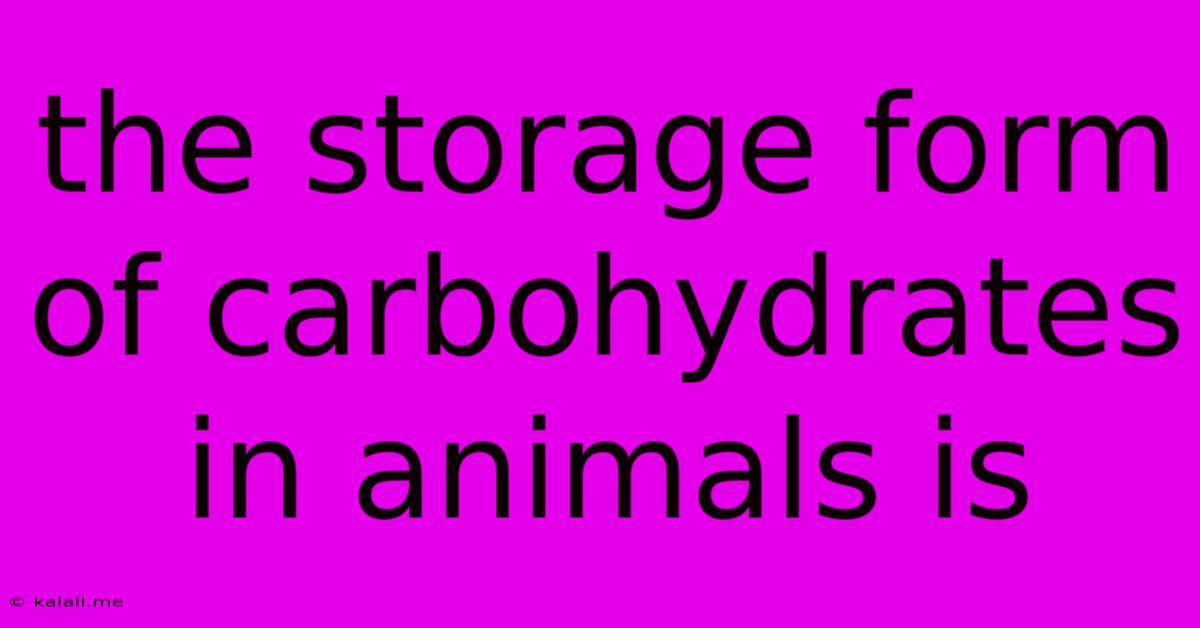The Storage Form Of Carbohydrates In Animals Is
Kalali
Jun 15, 2025 · 3 min read

Table of Contents
The Storage Form of Carbohydrates in Animals is Glycogen
The primary storage form of carbohydrates in animals is glycogen. Unlike plants, which store glucose as starch, animals utilize glycogen for short-term energy storage. This article will delve into the details of glycogen, its structure, location, and its crucial role in maintaining blood glucose levels and providing readily available energy for cellular processes. Understanding glycogen is essential for comprehending various physiological processes and metabolic disorders.
What is Glycogen?
Glycogen is a highly branched polysaccharide composed of glucose units linked together by glycosidic bonds. Its highly branched structure allows for rapid mobilization of glucose molecules when energy is needed. This is a key difference compared to starch, which has a less branched structure and thus slower glucose release. The branching increases the number of non-reducing ends, providing many sites for enzymatic action during glycogenolysis (the breakdown of glycogen). This is crucial for the rapid release of glucose to meet the body's immediate energy demands.
Where is Glycogen Stored?
Glycogen is primarily stored in two locations within the body:
- Liver: The liver serves as the main storage site for glycogen, acting as a glucose buffer for maintaining blood glucose homeostasis. When blood sugar levels drop, the liver breaks down glycogen (glycogenolysis) and releases glucose into the bloodstream, preventing hypoglycemia.
- Muscles: Muscles also store significant amounts of glycogen, but this glycogen is primarily used to fuel muscle contractions. Unlike liver glycogen, muscle glycogen is not readily released into the bloodstream to maintain blood glucose levels. This is because muscle cells lack the enzyme glucose-6-phosphatase, necessary for releasing free glucose into the circulation.
The Structure of Glycogen: A Detailed Look
The glycogen molecule is a large, complex structure. It's characterized by its many branches, created by α-1,6-glycosidic linkages, in addition to the α-1,4-glycosidic linkages that form the linear chains. These branches are crucial for the efficient and rapid breakdown of glycogen into glucose units. The core of the glycogen molecule is often a protein called glycogenin. This protein acts as a primer for glycogen synthesis, initiating the process of adding glucose units.
Glycogen Metabolism: Synthesis and Breakdown
The process of glycogen synthesis (glycogenesis) involves several enzymes, including glycogen synthase, which is the key enzyme responsible for adding glucose units to the growing glycogen chain. Conversely, glycogenolysis, the breakdown of glycogen, involves the action of glycogen phosphorylase, which cleaves glucose units from the non-reducing ends of the glycogen molecule. The intricate regulation of these metabolic pathways ensures that glycogen stores are appropriately built up and broken down to meet the body's energy needs. Hormones like insulin and glucagon play a significant role in regulating glycogen metabolism.
The Importance of Glycogen in Maintaining Blood Glucose Levels
The liver's glycogen stores are crucial for maintaining stable blood glucose levels. This is especially important between meals or during periods of fasting. When blood glucose levels fall, the liver releases glucose from its glycogen stores, preventing hypoglycemia, a condition characterized by dangerously low blood sugar.
Glycogen and Athletic Performance
Muscle glycogen stores are essential for athletic performance, particularly during high-intensity exercise. Sufficient glycogen levels provide the energy needed for muscle contraction and optimal performance. Depleted glycogen stores can lead to fatigue and reduced endurance. Athletes often utilize carbohydrate loading strategies to maximize muscle glycogen storage before competition.
In conclusion, glycogen is the primary storage form of carbohydrates in animals, playing a vital role in energy metabolism and maintaining blood glucose homeostasis. Its highly branched structure facilitates rapid glucose mobilization, making it an ideal energy reserve for the body's diverse energy demands. Understanding the intricacies of glycogen metabolism is essential for comprehending various physiological processes and metabolic conditions.
Latest Posts
Latest Posts
-
The Bat Is The Only Mammal That Can Fly
Jun 15, 2025
-
A Process By Which Two Pieces Of Metal Are Joined
Jun 15, 2025
-
Which Of The Following Does Not Contribute To Water Pollution
Jun 15, 2025
-
Which Of The Following Equations Is Correct
Jun 15, 2025
-
A Group Of Similar Cells Performing A Specific Function
Jun 15, 2025
Related Post
Thank you for visiting our website which covers about The Storage Form Of Carbohydrates In Animals Is . We hope the information provided has been useful to you. Feel free to contact us if you have any questions or need further assistance. See you next time and don't miss to bookmark.